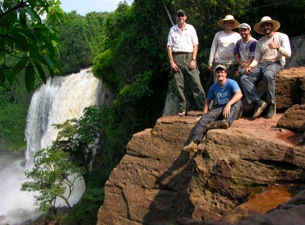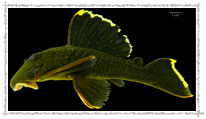The Pipe Expedition
Expedição Serra do Cachimbo

The Pipe Expedition
The Pipe Expedition was an ichthyological survey of the Serra do Cachimbo in Brazil. The aim of the expedition was to sample a very species-rich and poorly known ichthyofaunal region in the Neotropics. The Serra do Cachimbo is the highest portion (up to 500 m a.s.l,; Klammer, 1984) of the Brazilian shield in the Amazon region. The headwaters from both middle Xingu basin (Rio Curua) and middle Tapajos (Rio Jamanxim basin and the tributaries of Rio Teles Pires) lie in this region. As noted by Goulding, Barthem & Ferreira (2003), “magnificient waterfalls drop off Serra do Cachimbo tablelands. Small blackwater rivers are found in the sandy parts of the Serra do Cachimbo, but most rivers are crystalline. Fish populations have probably been isolated in the areas above the waterfalls and there are probably many endemic species”. Only two small collections have been previously made in the region, the first in 1956 by Lauro Travassos, whose fishes were studied and four species described by Haroldo Travassos in 1960 and 1964, all of them characids. The second was made by Michael Goulding in 1984, from which another new species of characid was recently described (Lima & Birindelli, 2006). Moreover, the region composed by the headwaters of the Tapajos, Xingu, and Araguaia, mainly in the states of Mato Grosso and Pará, is probably the region of Brazil where the anthropogenic impact is most intense and rapid, mainly due to soy crops and hydroelectric power dams. This region has been enormously altered in the last decade. The threat of species extinction prior to their description due to habitat destruction, makes this expedition a top priority, for conservational purposes.
A team of 5 people went into the field, including José Luís Birindelli, Leandro Melo de Sousa and André Netto Ferreira from Museu de Zoologia da USP, Mark Henry Sabaj Pérez from Academy of Natural Sciences of Philadelphia, and Nathan Lujan from Auburn University. Permits for the two American ichthyologists were obtained throughout brazilian agency of research, CNPq, license: EXC 006/07, Expedição Serra do Cachimbo, conforme consta na Portaria MCT no. 466, publicada no Diário Oficial da União de 24/07/2007. The field trip was executed in 18 days, from October 15th to November 1st and explored different localities in the Tapajos and Xingu basins. Samples were made in various habitats, including main channels, small streams, and lakes, using several collecting methods (cast-nets, gill-nets, seine, dip-nets, and hook and line), and during day and especially night.
The expedition was funded by the All Catfish Species Inventory project (NSF DEB-0315963).
The expedition resulted in the collection of important ichthyological material, summing nearly 250 species of fishes, including at least 86 species of Siluriformes, from which approximately 35 (40%) are considered to be new to science. Furthermore, additional material from poorly known described species, such as, for example, Sorubim trigonocephalus, Centromochlus schultzi, Cetopsis sandrae, Hopliancistrus tricornis, and molecular tissue of most Siluriformes species collected were also preserved and may prove to be important to the systematics of neotropical catfishes.







